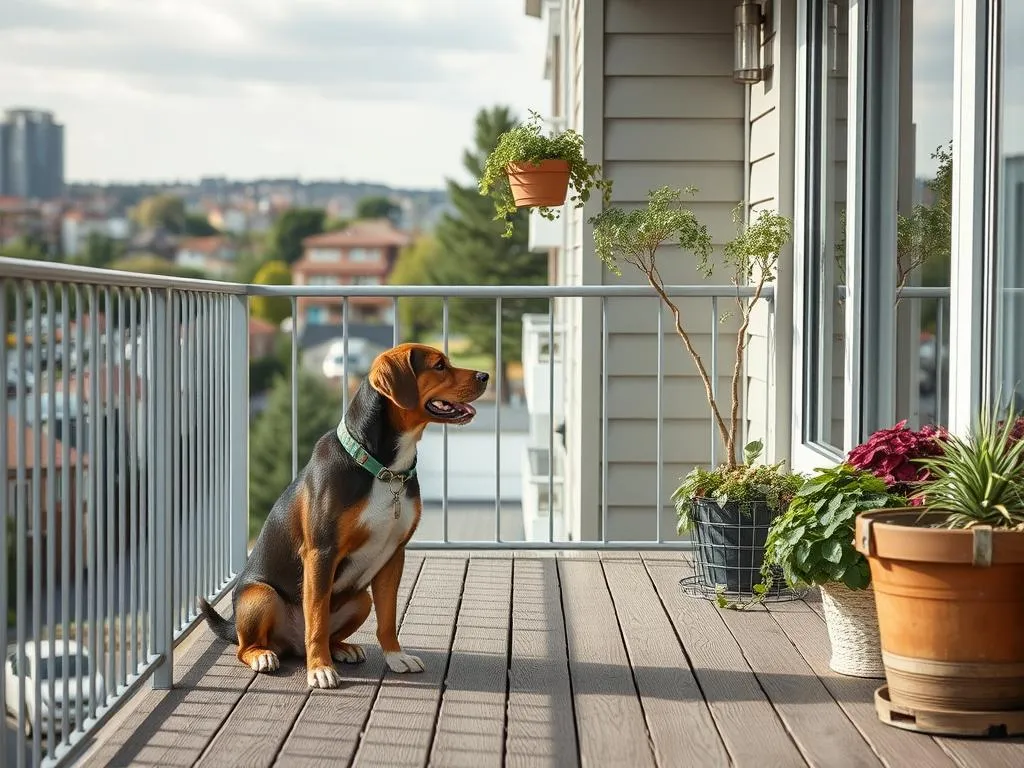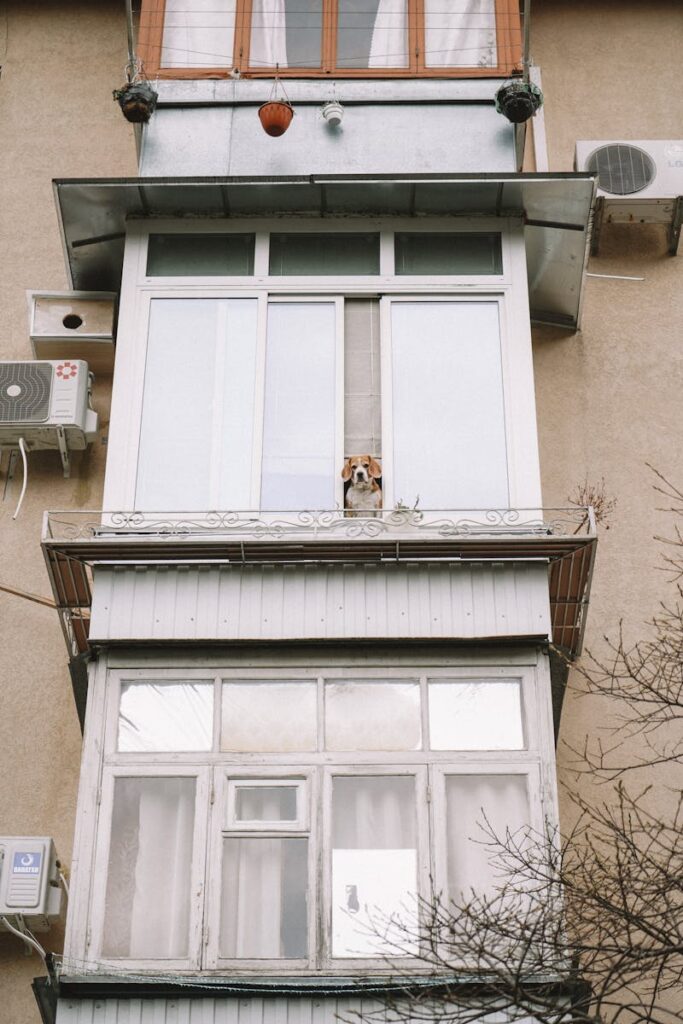
Keep your furry friend safe and secure with this comprehensive guide to dog-proofing your balcony. Learn essential safety measures, recommended materials, and expert tips to create a pet-friendly outdoor space.
Understanding the Importance of Balcony Safety for Dogs
Living in an apartment or high-rise building with a dog comes with unique challenges, particularly when it comes to balcony safety. Dogs are naturally curious creatures, and even well-behaved pets can be startled by sudden noises or become excited by passing birds, potentially putting themselves at risk. Creating a secure environment isn’t just about peace of mind – it’s essential for your pet’s well-being.
Assessing Your Balcony’s Current State
Before beginning any dog-proofing projects, evaluate your balcony’s existing conditions:
Your first step should be examining the current safety features and potential hazards. Look for gaps in railings, loose materials, or deteriorating structures that could pose risks. Check local building codes and regulations regarding balcony modifications, especially if you’re renting.
Common Balcony Risks for Dogs
Understanding potential dangers helps prioritize safety measures:
Railing gaps pose one of the biggest risks, as small to medium-sized dogs might squeeze through them. Slippery flooring becomes hazardous when wet, while scattered items can become projectiles in strong winds. Plants on your balcony might be toxic to dogs, and direct sun exposure without shade can lead to overheating.
Essential Steps to Dog Proof Your Balcony

1. Installing Proper Barriers
The most crucial aspect of dog-proofing your balcony is installing appropriate barriers. Consider these options:
Plexiglass panels offer excellent visibility while blocking gaps in railings. They’re weather-resistant and won’t obstruct your view. Alternatively, heavy-duty mesh or netting provides good airflow while preventing accidents. Ensure any barrier material extends from the floor to a height taller than your dog can reach when standing on hind legs.
2. Flooring Modifications
Creating safe flooring prevents slipping and ensures comfort:
Install artificial grass or rubber mats designed for outdoor use. These materials provide traction and comfort while being easy to clean. Some options include:
- Interlocking deck tiles with drainage capabilities
- Weather-resistant outdoor carpeting
- Anti-slip rubber mats with proper drainage holes
3. Creating Shade and Weather Protection
Protecting your dog from the elements is crucial:
Install retractable awnings or shade sails to provide relief from direct sunlight. Consider adding a small covered area where your dog can retreat during sudden weather changes. Ensure any installed items are securely fastened to withstand strong winds.
Safety Features and Accessories
Monitoring Systems
Consider installing pet cameras to monitor your dog when you’re not present. Modern systems offer two-way communication, allowing you to calm your pet if needed.
Emergency Preparations
Keep these essential items on your balcony:
- Fresh water bowl with secure, tip-proof holder
- Weather-appropriate pet bed or cooling mat
- First-aid supplies in a waterproof container
- Emergency contact information visible and accessible
Making the Space Dog-Friendly
Designated Bathroom Area
If you plan to let your dog use the balcony for bathroom breaks:
Create a specific potty area using artificial grass with proper drainage. Include a cleaning station with waste bags and sanitizing supplies. Consider installing a small irrigation system for easy cleaning.
Entertainment and Enrichment
Keep your dog engaged safely:
Add dog-safe toys that can’t roll off the balcony. Install puzzle feeders or snuffle mats for mental stimulation. Create comfortable lounging areas where your dog can observe the surroundings safely.
Maintenance and Regular Safety Checks
Daily Inspections
Implement a routine checking system:
- Examine barriers for any signs of wear or damage
- Check flooring for wet spots or tripping hazards
- Ensure all installed features remain securely fastened
- Remove any accumulated debris or foreign objects
Seasonal Considerations
Adjust your balcony setup based on weather changes:
During summer, ensure adequate shade and cooling options. In winter, provide warm, weather-protected areas. Consider adding wind barriers during stormy seasons while maintaining proper ventilation.
Training Your Dog for Balcony Safety
Establishing Boundaries
Proper training ensures your dog understands balcony rules:
Start with short, supervised visits to familiarize your dog with the space. Use positive reinforcement to establish boundaries and safe behaviors. Teach basic commands specific to balcony safety, such as “back” or “leave it.”
Monitoring Behavior
Watch for signs of anxiety or unsafe behavior:
Some dogs may feel uncomfortable at heights or become overexcited by external stimuli. Observe your pet’s reaction to the balcony environment and adjust safety measures accordingly.
Legal and Insurance Considerations
Rental Properties
If you’re renting, take these steps:
Obtain written permission for any modifications from your landlord. Review your lease agreement regarding pet policies and balcony use. Document all safety improvements with photos and receipts.
Insurance Coverage
Protect yourself legally:
Check your renter’s or homeowner’s insurance regarding pet-related incidents. Consider additional coverage if needed for peace of mind.
Professional Installation vs. DIY
When to Hire Professionals
Consider professional installation for:
- Major structural modifications
- Complex barrier systems
- Electrical or plumbing work for drainage systems
- Safety features requiring specialized tools or expertise
DIY Safety Tips
If handling installations yourself:
Use appropriate tools and safety equipment. Follow manufacturer instructions carefully. Test all installations thoroughly before allowing pet access.
Cost Considerations and Budgeting
Essential vs. Optional Features
Prioritize spending on critical safety elements:
- Barriers and gap protection (highest priority)
- Non-slip flooring solutions
- Weather protection features
- Monitoring systems (if needed)
Long-term Value
Consider the investment in terms of:
- Durability of materials
- Maintenance requirements
- Potential property value impact
- Peace of mind regarding pet safety
Conclusion
Creating a dog-safe balcony requires careful planning, appropriate materials, and ongoing maintenance. By following these comprehensive guidelines, you can transform your balcony into a secure and enjoyable space for your canine companion. Remember that safety should always be the primary concern, and regular updates to your safety measures may be necessary as your dog grows or as seasons change.









